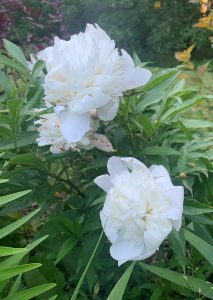June 20, 2022 Pass-along Plants
June 20, 202
 Pass-along Plants
Pass-along Plants
“It’s exciting to see things coming up again, plants that you’ve had twenty or thirty years. It’s like seeing an old friend.”
– Tasha Tudor
I was excited to see my white peony bush finally bloomed this year. It was a piece of a peony that our former horticulture educator, Phyllis Both, gave me the summer before she passed away. It came from the plant that originally was a division of the peony bush her grandmother brought over from Poland. This is an example of a pass-along plant – one that is easy to propagate from seed, cuttings, or divisions and typically hard to kill.
The idea of the pass-along plant is not new. Most gardeners dislike tossing a perfectly good plant into the compost pile if they have too many; they’d rather “pass along” those plants with others. Pioneer women would bring seeds, cutting, and bulbs from home to help them establish their new gardens and to remind them of home. During the Civil War, Southerners had to rely on pass-along plants due to the blockade the North imposed on the Southern ports. For many of us today, a pass-along plant in our garden is a reminder of a particular person.
I have numerous pass-along plants in my garden. I have evening primrose (Oenothera speciosa) in my garden and every time it blooms, it reminds me of my grandmother – the one who first introduced me to gardening. The purple iris that smells like grape bubble gum are from my mother-in-law. Master gardener friends from Missouri gifted me with a Black Gamecock Louisiana Iris, pink Japanese Anemone, and several unique daylilies. I have daffodils and beautiful lavender mums from my sister, Shelly. My friend, John, gave me numerous huge cannas that are planted throughout my garden. I have a huge blue-green Hosta that was pass-along to me from my friend, Kent. Of course, the white peony is a reminder of my dear friend and mentor, Phyllis Both. As I don’t know exactly what the variety is of the Hosta or the peony, I simply named those plants Kent and Phyllis. These are just a few examples of the pass-along plants in my garden. Every time I see those plants, it reminds me of those people who I share a love of gardening with me.
I’m not just the recipient of pass-along plants; I also like to share my plants with garden visitors. It’s not unusual for me to walk through the garden with a shovel and pail in hand, ready to dig something my visitors have admired. Last year, I passed-along a piece of an orange iris to my daughter, that was originally passed-along to me from a fellow master gardener. It bloomed beautifully this year for my daughter, she called it her “crown jewel”. Mine didn’t bloom; it was too crowded by the yellow false indigo (Baptisia) and Black-eyed Susan (Rudbeckia hirta).
There are some “rules” to follow regarding pass-along plants. If you receive a pass-along plant, you shouldn’t say “thank you” or the plant will fail to thrive. Instead, you promise to take good care of the plant. If you are the one passing along a plant, especially to newer gardener, be careful not to pass along something that is considered invasive or aggressive in the garden. That makes me thing of spider wort, clustered bell flower, or trumpet vine. I know their nature, so I’m very careful not to share them with “newbies”. Also refrain from sharing plants if your garden is plagued with jumping worms or other problems.
If you visit my garden during the Sauk County Master Gardeners Association’s 2022 Annual Garden Tour on July 30th, who knows – you just might get a pass-along plant as well. To purchase tickets, visit Eventbrite.com and search for SCMGA Garden Tour.
This week’s article is written by Jeannie Manis, a Wisconsin Certified Sauk County Master Gardener Volunteer. If you have any gardening questions, please contact the Extension Sauk County by emailing to trripp@wisc.edu or calling the University of Wisconsin Madison Division of Extension Sauk County office at 608-355-3250.




